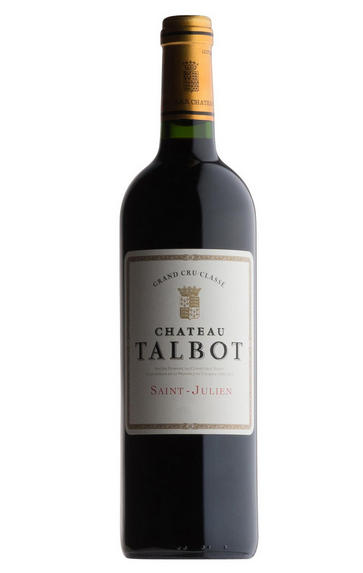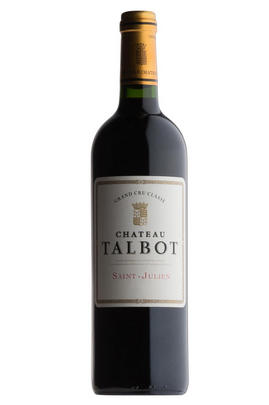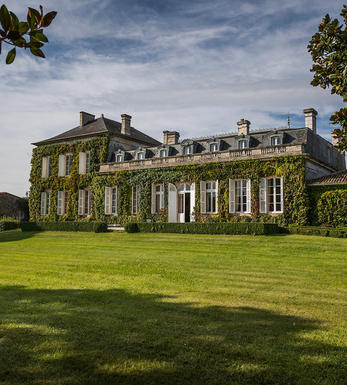
2017 Château Talbot, St Julien, Bordeaux

Critics reviews
The 2017 Talbot was picked from 18 to 4 October using manual and optical sorting and matured in 50% new oak. It has a relatively light but well-defined, floral bouquet, pressed flower filtering through that blackberry and boysenberry scents, a little clove and bay leaf lending complexity as it opens in the glass. The palate is medium-bodied with fine but firm tannins that frame the slightly savoury black fruit, with just a little earthiness developing towards the finish. It is a classic Talbot really, exactly what you would expect for the vintage.
Drink 2020 - 2036
Neal Martin, Vinous.com (May 2018)
The 2017 Talbot is powerful and rustic, just as it was En Primeur. Black cherry, plum, grilled herbs, leather, menthol and scorched earth add to the wine's brooding, potent feel. The 2017 remains a rather rustic Saint-Julien. It will be interesting to see if the tannins soften over time. For now, there is a good bit of character, if not exactly a ton of finesse.
Drink 2022 - 2037
Antonio Galloni, Vinous.com (March 2020)
Delicate red fruits, showing lovely precision and balance, and soft but unmistakable concentration of menthol and crushed earth notes on the finish. No need to wait too long, there are plenty of tannins here but they are not overpowering the fruit even at this early stage. Slight pyrazine notes stop the fruit from fully expanding, but this is an enjoyable wine.
Drink 2023 - 2040
Jane Anson, JaneAnson.com (November 2019)
68% Cabernet Sauvignon, 26% Merlot, 6% Petit Verdot.
Fresh and fragrant but only just beginning to open. Accent on the fruit with both red- and dark-fruit notes. Light but fine tannic frame. Attractive in a clean, precise, elegant way. Ripe but lacks the substance of a great year so more for medium-term ageing. A touch short on the finish.
Drink 2024 - 2035
James Lawther MW, JancisRobinson.com (March 2022)
The 2017 Talbot is medium to deep garnet-purple in colour with aromas of cedar, black cherries, mulberries and warm blackcurrants with touches of earth, tree bark and herbs. The palate is medium-bodied, firm, grainy and muscular with an earthy finish.
Drink 2020 - 2033
Lisa Perrotti-Brown, Wine Advocate (March 2020)
Impressive depth of fruit and structure to this 2017 with currant, plum and light chocolate character, medium to full body and round, lightly chewy tannins. Flavorful and long. Dialled-in quality here.
Drink after 2022
James Suckling, JamesSuckling.com (January 2020)
Complex aromas of intense blackcurrant, dark cherries, plums and hints of chocolate, violet and leafy notes. Generous and appealing, showing tension and precision with slightly grippy tannins.
Drink 2023 - 2045
Georgina Hindle, Vincenzo Arnese, Andy Howard MW, Decanter.com (February 2022)
About this WINE

Chateau Talbot
Château Talbot is one of the best-known Bordeaux wine estates to a UK audience, not surprisingly because it takes its name from John Talbot, Earl of Shrewsbury, who in 1453 suffered the ignominy of losing the battle, and with it his life, which allowed Bordeaux and its vineyards to slip back into French control after belonging to the British Crown for over 340 years.
In the last century it has been owned by the Cordier family, and the red wine of the estate has long enjoyed a reputation for solid dependability. It is one of the largest estates in the Médoc and its 102 hectare single vineyard is situated inland from the Gironde River and west of the hamlet of St-Julien-Beychevelle.
Georges Cordier, who owned the property in the mid-20th century, was a great lover of white wine, and, determined to produce his own, took the highly unusual step of planting 5 hectares of Sauvignon Blanc and Semillon in his vineyard, producing his first crop of white wine in 1945 (Le Caillou Blanc de Ch Talbot). The aim is to make wine in a Burgundian style, aged in oak barrels, with the 80% Sauvignon Blanc imparting vivacity and acidity, while the 20% Semillon imbues the wine with weight, backbone and ageing potential.
Red wine from Talbot is typically a blend of Cabernet Sauvignon (66%), Merlot (26%), Cabernet Franc (3%), and Petit Verdot (5%) - the vinification includes 18 months maturation in small oak barriques (50% new).
Talbot has a reputation for consistency and is one of the most carefully made and reliable of the St-Julien Cru Classé clarets. The best examples are richly aromatic with a bouquet of cedarwood and vanilla scented cassis fruits and with a palate packed with well-delineated, ripe, black fruits and finely integrated tannins. It is classified as a 4ème Cru Classé.

St Julien
St Julien is the smallest of the "Big Four" Médoc communes. Although, without any First Growths, St Julien is recognised to be the most consistent of the main communes, with several châteaux turning out impressive wines year after year.
St Julien itself is much more of a village than Pauillac and almost all of the notable properties lie to its south. Its most northerly château is Ch. Léoville Las Cases (whose vineyards actually adjoin those of Latour in Pauillac) but, further south, suitable vineyard land gives way to arable farming and livestock until the Margaux appellation is reached.
The soil is gravelly and finer than that of Pauillac, and without the iron content which gives Pauillac its stature. The homogeneous soils in the vineyards (which extend over a relatively small area of just over 700 hectares) give the commune a unified character.
The wines can be assessed as much by texture as flavour, and there is a sleek, wholesome character to the best. Elegance, harmony and perfect balance and weight, with hints of cassis and cedar, are what epitomise classic St Julien wines. At their very best they combine Margaux’s elegance and refinement with Pauillac’s power and substance.
Ch. Léoville Las Cases produces arguably the most sought-after St Julien, and in any reassessment of the 1855 Classification it would almost certainly warrant being elevated to First Growth status.
Recommended Châteaux: Ch. Léoville Las Cases, Ch.Léoville Barton, Ch Léoville Poyferré, Ch. Ducru-Beaucaillou, Ch Langoa Barton, Ch Gruaud Larose, Ch. Branaire-Ducru, Ch. Beychevelle

Cabernet Sauvignon Blend
Cabernet Sauvignon lends itself particularly well in blends with Merlot. This is actually the archetypal Bordeaux blend, though in different proportions in the sub-regions and sometimes topped up with Cabernet Franc, Malbec, and Petit Verdot.
In the Médoc and Graves the percentage of Cabernet Sauvignon in the blend can range from 95% (Mouton-Rothschild) to as low as 40%. It is particularly suited to the dry, warm, free- draining, gravel-rich soils and is responsible for the redolent cassis characteristics as well as the depth of colour, tannic structure and pronounced acidity of Médoc wines. However 100% Cabernet Sauvignon wines can be slightly hollow-tasting in the middle palate and Merlot with its generous, fleshy fruit flavours acts as a perfect foil by filling in this cavity.
In St-Emilion and Pomerol, the blends are Merlot dominated as Cabernet Sauvignon can struggle to ripen there - when it is included, it adds structure and body to the wine. Sassicaia is the most famous Bordeaux blend in Italy and has spawned many imitations, whereby the blend is now firmly established in the New World and particularly in California and Australia.


Buying options
Add to wishlist
Description
68% Cabernet Sauvignon, 26% Merlot, 6% Petit Verdot.
Fresh and fragrant but only just beginning to open. Accent on the fruit with both red- and dark-fruit notes. Light but fine tannic frame. Attractive in a clean, precise, elegant way. Ripe but lacks the substance of a great year so more for medium-term ageing. A touch short on the finish.
Drink 2024 - 2035
James Lawther MW, JancisRobinson.com (March 2022)
wine at a glance
Delivery and quality guarantee